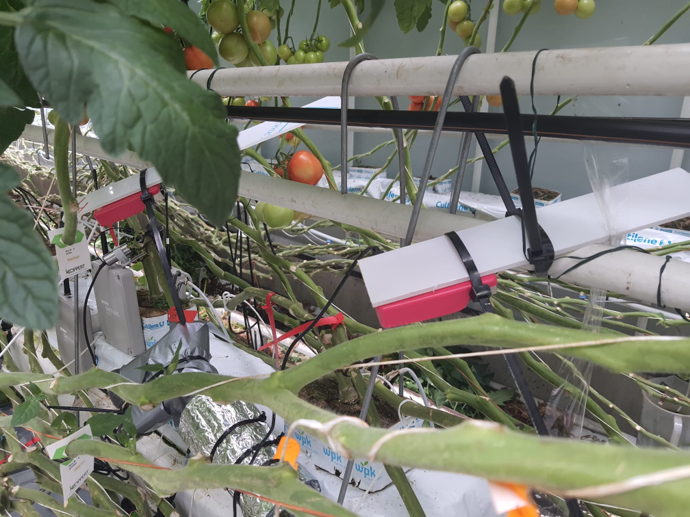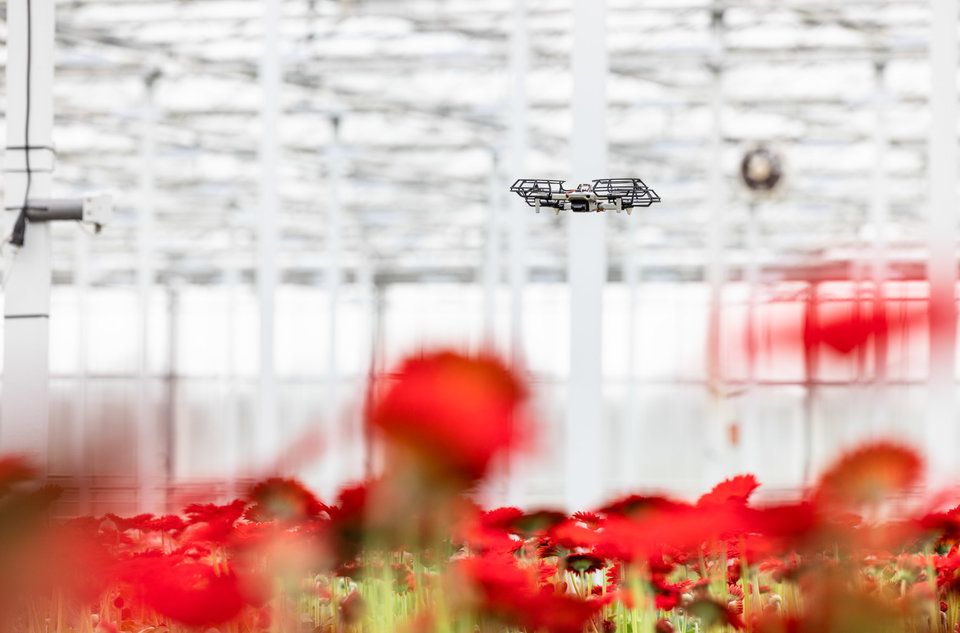Activeer hoog contrast
Ga naar hoofdcontent
Latest news

24 augustus 2022
Plantenna Demonstrator
How do plant respond to drought? At what point do they start to experience stress that, for instance, affects the quality of their fruits? To what extent can they recover after a drought period? These are important questions to answer in times of increasing drought like the one we’re experiencing this summer. In Plantenna, a 4TU collaboration project, we are developing novel sensors to detect early signs of stress in plants. The aim is to make the sensors low-cost and fully autonomous for easy application in the field. This summer, we’re putting the sensors to the test: ultrasound microphones, radars, a stomatoscope and many other measurement devices are installed in a tomato greenhouse at Delphy Improvement Center in Bleiswijk. We’re conducting a series of drought experiments to test the sensors’ capabilities. But we learn a lot more: 3D temperature measurements at very high (25cm) resolution will show the heat distribution in the greenhouse. A dozen soil moisture sensors combined with sap flow and leaf temperatures will tell us whether the plants can "sweat" enough to keep themselves cool. Thus, we intend to obtain a better understanding of the plants’ response to drought stress. At the same time, we evaluate the usefulness of the newly developed Plantenna sensing techniques for monitoring plant health in greenhouses and fields. In the future, networks of these sensors can help farmers to protect their crops against drought, to ensure food supplies and prevent famine. A major challenge has proven to be to keep the researchers cool during all these activities: temperatures at the top of the tomato canopy are rising to almost 40C at midday, quite a test to the team’s heat resilience! For more information please contact: Marie-Claire ten Veldhuis Faculty of Civil Engineering and Geosciences, Watermanagement j.a.e.tenveldhuis@tudelft.nl

02 juni 2022
Self-flying drones that monitor greenhouses
Self-flying drones that monitor greenhouses TU Delft, Royal Brinkman and start-up Mapture have developed the next step in drone technology for agriculture. Their new AI-enabled drone takes off completely independently, flies over rows of plants and people in a greenhouse, takes high-resolution photos, and lands safely back on its charging station. The photos provide growers with information about diseases and pests much more quickly. The drone is a long-established and proven way to collect large-scale and autonomous data, but most current self-flying drones operate only outdoors, high in the sky. Guido de Croon, professor of bio-inspired drones at TU Delft said that the reason relates to GPS: “Drones typically rely on GPS to know where they are and where to go. In indoor spaces, such as greenhouses, GPS is not reliable enough for navigation when flying autonomously. At the Faculty of Aerospace Engineering we are working on light, small drones that can fly independently using AI. This is important, because such drones are very safe for humans, who don’t need to take extra safety measures when flying the drones. Making such a light drone fly independently is a major challenge, because they have far fewer sensors and less on-board computing power than, for example, a self-driving car. We have developed a localization technique – the drone combines signals from radio beacons in the greenhouse with its own observations to find its location as precisely as possible.” Read more...

24 februari 2022
TU Delft spin-offs piloting at Koppert Cress
Every year many TU Delft spin-offs develop services or products based on acquired scientific knowledge. Many of these young companies find their way to start-up incubator YES!Delft. In almost all cases, being able to talk to end users and test in an operational or at least realistic test environment is crucial for successful validation and market introduction of the product. This certainly also applies to AgTech start-ups, where being able to test a product in a greenhouse or in a field provides very valuable feedback for validation. In practice, however, it is not always easy for start-ups to find locations, partners or funding for this phase in their development. Koppert Cress in Monster (municipality Westland) stepped in and offers several TU Delft spin-offs the opportunity to test their innovations in an actual greenhouse. Koppert Cress is of course known as a grower of various types of fresh cresses, edible flowers and leaves and and the production of Dutch vanilla , but is also a front-runner in applying technical innovations Koppert Cress is facilitating pilots for the following TU Delft Spin-offs: PHYSEE has developed a PAR+-coating which can be applied on greenhouses in order to improve the light quality. The PAR+-coating contains luminescent UV to PAR particles which make the light diffuse. This coating is unique, as part of the harmful UV radiation is converted into useful PAR light enabling hortiscatter without PAR losses. PHYSEE has applied 50m2 of PAR+-coating on a greenhouse of Koppert Cress to measure the impact of the coating on various crops. PATS is developing insect scouting and bat-like drone technology to identify and eliminate harmful insects like the Turkish moth. PATS is piloting autonomous and biological insect control technology at Koppert Cress. BBBLS is developing the Energy Saving Greenhouse using various technological innovations. One of their main innovations is a method of providing extra insulation for greenhouses with soap bubbles. Together with Koppert Cress and other project partners, BBBLS is developing a crop experimentation and demonstration of BBBLS Energy Saving Greenhouse. Thermeleon is developing innovative heat storage solutions. The products of Thermeleon enable heat storage in the greenhouse construction, floor and even in moving screens. This makes the greenhouse an actual heat battery. The pilot at Koppert Cress helps Thermeleon in the selection of configuration and in their solutions.
Upcoming events
Past events